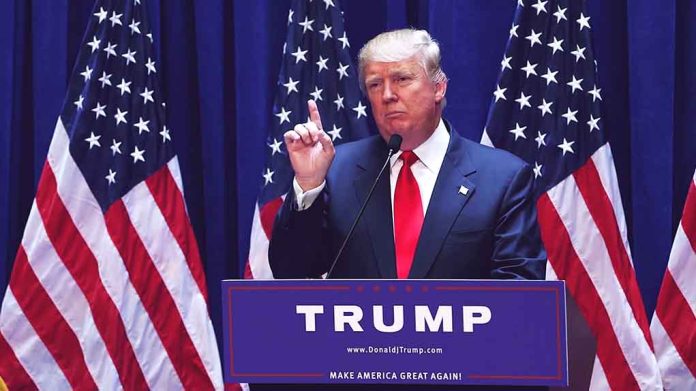
President Trump’s five-point battle plan to secure the GOP’s narrow House majority against Democrats’ third impeachment threats relies on early endorsements, massive fundraising efforts, and passing the “One Big Beautiful Bill Act” before voters head to the polls in 2026.
Key Takeaways
- Republicans hold just an eight-seat advantage in the House, putting Trump at risk of impeachment inquiries if Democrats regain control in 2026
- The “One Big Beautiful Bill Act” aims to make Trump’s 2017 tax cuts permanent, end taxes on tips and overtime pay, and boost border security funding
- Trump’s strategy includes preventing GOP retirements, raising significant campaign funds, and making early endorsements to avoid primary battles
- Trump has already raised over $35 million for the National Republican Congressional Committee, with plans to deploy his $500 million political apparatus for competitive races
- Elon Musk’s decision to halt political spending represents a significant setback for Republican fundraising efforts
Trump’s Legislative Strategy to Secure GOP Midterm Success
House Republicans have pinned their 2026 midterm hopes on the “One Big Beautiful Bill Act,” a comprehensive package aimed at delivering tangible economic benefits to voters well before they head to the polls. The bill would make Trump’s 2017 tax cuts permanent, eliminate taxes on tips and overtime pay, end taxes on car loan interest, boost border and defense spending, enact Medicaid reforms, and reclaim unused green-energy tax credits. This legislative push comes as Republicans face the historical challenge that the party in power typically loses congressional seats during midterm elections.
“We want to ensure that people can feel the effects of it well in advance of the midterm elections,” said Mike Johnson. “While Democrats are throwing fits, impeding law enforcement, playing political games, and demonstrating how far out of touch they are — Republicans are working to deliver lower taxes for families, restore American energy dominance, strengthen border security, restore peace through strength, and make government work more efficiently and effectively. The contrast has never been more clear.”
The bill’s passage through the House was narrow, requiring last-minute adjustments to Medicaid work requirements to secure votes from conservative holdouts. Polling shows strong support for the bill’s provisions among registered voters, particularly in key battleground districts where Republicans need to maintain their seats. With the GOP holding a slim 220-212 majority over Democrats, every legislative win that resonates with voters becomes crucial to their midterm strategy.
Trump’s Five-Point Plan to Maintain House Control
President Trump has developed a comprehensive five-step strategy to preserve the Republican majority in the House, recognizing that Democratic control would likely lead to renewed impeachment efforts. The plan begins with preventing Republican lawmakers from leaving their seats through retirement or pursuing other offices. Trump has already intervened in several cases, including endorsing New York Representative Mike Lawler to remain in his current position despite Lawler’s interest in running for governor.
“[Trump] knows the stakes firsthand. He saw what could happen. It’s clear he doesn’t want that again. Investigations, impeachment – he knows it’s all on the table,” said Republican strategist Matt Gorman.
The second pillar of Trump’s strategy involves massive fundraising efforts. Having already raised over $35 million for the National Republican Congressional Committee at a single dinner event, Trump plans to deploy his $500 million political apparatus through PACs like Securing American Greatness and Never Surrender to support competitive races. This financial firepower becomes even more critical following Elon Musk’s unexpected decision to halt political spending after contributing $288 million to Trump’s campaign.
Candidate Recruitment and Early Endorsements
The third and fourth components of Trump’s strategy focus on candidate quality and preventing messy primary battles. Trump has positioned himself as a “closer” in recruiting strong candidates for swing districts, particularly in areas without GOP incumbents. His team understands that candidate quality significantly impacts electoral outcomes, especially in competitive districts where margins of victory can be razor-thin.
“A promise of Trump’s help and an endorsement can be key in getting a wanted recruit to make the leap,” Stated Gorman.
Early endorsements represent the fifth element of Trump’s plan, designed to prevent the infighting that has plagued previous Republican primary seasons. By signaling his preference early, Trump aims to clear the field for his chosen candidates and focus resources on defeating Democrats rather than fighting internal battles. This approach reflects lessons learned from past elections where divisive primaries left Republican nominees weakened for general election contests.
The Stakes: Avoiding a Third Impeachment
Republicans are acutely aware of what losing the House would mean for President Trump’s second term. Democrats have already signaled their intent to launch investigations into various aspects of Trump’s administration and business dealings, including allegations of insider trading, acceptance of foreign gifts like a reported $400 million jet from Qatar, and Elon Musk’s potential profits from defense contracts. Such investigations could potentially lead to a third impeachment attempt against Trump.
“House Democrats have already provided just a small preview of what a Democratic majority would bring: distractions, division, and nonstop Trump Derangement Syndrome,” Said Mike Marinella.
For Trump, who experienced two impeachments during his first term, maintaining the Republican House majority isn’t just about advancing his legislative agenda—it’s about ensuring his administration can govern without the constant threat of investigations and impeachment proceedings. This reality has made the 2026 midterms a top priority for the White House almost from day one of Trump’s second term, with planning and strategy development beginning well in advance of the traditional campaign timeline.













